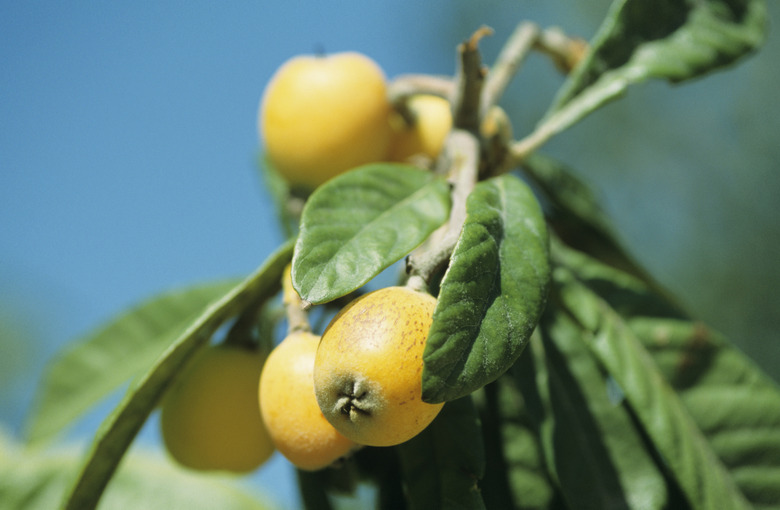Loquat Root Invasiveness
The charming loquat tree (Eriobotrya japonica), sometimes called the Japanese plum, grows up to 20 feet tall and yields fragrant flowers in addition to delicious fruit. It has shallow, wide-spreading roots, and although it is an introduced tree native to Asia, it is not invasive. You can grow it in U.S. Department of Agriculture plant hardiness zones 7 through 11.
Step 1
Glossy, dark green loquat leaves grow in whorls. Loquat trees yield clusters of small white flowers in fall and beautiful, ripe fruit in late winter and early spring. Loquats need to stop growing in the fall, either because of low temperatures or drought, before they will bloom. Round to pear-shaped loquats typically weigh 1 to 1 1/2 ounces although some cultivars weigh up to 2 1/2 ounces. The light-yellow to orange loquat peels are slightly downy to smooth. Their juicy, sweet to slightly acid pulp ranges from white or light yellow to orange and may contain from one to 10 dark brown seeds. A mature loquat tree may yield from 35 to 300 pounds of fruit a year.
Step 2
- Glossy, dark green loquat leaves grow in whorls.
- A mature loquat tree may yield from 35 to 300 pounds of fruit a year.
Climate
Step 1
Loquats are best suited to warm temperate and subtropical climates. They grow best when they stop growing in early fall followed by cool, but not freezing temperatures during the winter, then warming temperatures in spring. Winter or spring frosts will damage or kill developing loquats. They are also intolerant of temperatures above 95 degrees Fahrenheit.
Propagation
Step 1
You can grow a loquat from seed, but it will not be like its parent and you will have to wait from six to eight years for it to flower and fruit. Clean and plant the seeds immediately or store them for up to six months at 41 degrees. Seedlings grafted onto rootstock or loquats propagated by cutting, often available in nurseries, usually bear loquats in one to two years after planting. Avoid buying a large loquat in a small container because the tap root may be growing around the container in a circle, a condition known as being "root bound."
Step 2
- Loquats are best suited to warm temperate and subtropical climates.
- You can grow a loquat from seed, but it will not be like its parent and you will have to wait from six to eight years for it to flower and fruit.
Roots and Maintenance
Step 1
The shallow roots of a mature loquat tree will spread beyond the drip line of the tree's canopy. You can easily injure the roots with a weed eater or lawn mower. Maintain a grass-free area at least 2 to 5 feet from the trunk. You can cause dieback or kill your tree by damaging its roots or trunk. If you over-water a tree with a timed lawn sprinkler it can cause root rot.
